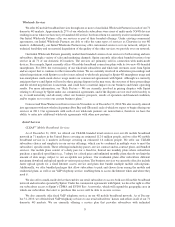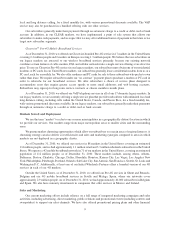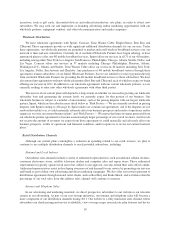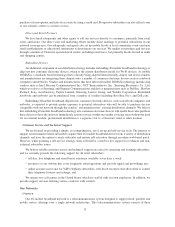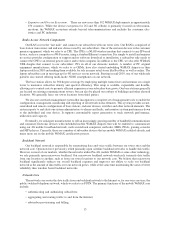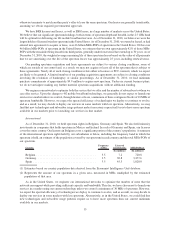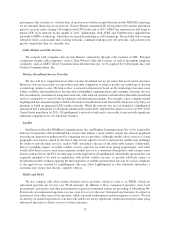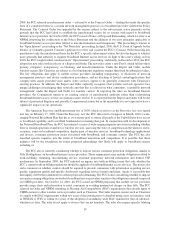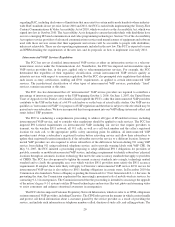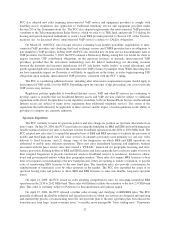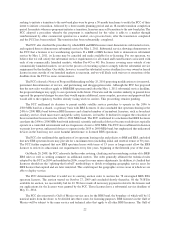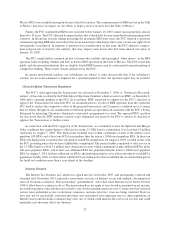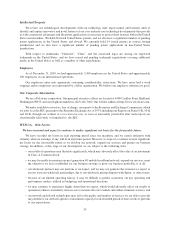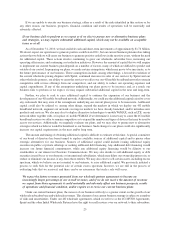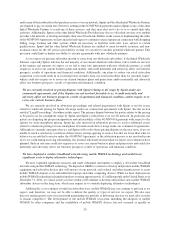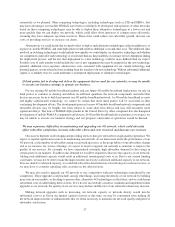Clearwire 2010 Annual Report Download - page 23
Download and view the complete annual report
Please find page 23 of the 2010 Clearwire annual report below. You can navigate through the pages in the report by either clicking on the pages listed below, or by using the keyword search tool below to find specific information within the annual report.International
In our international markets, we generally face competition from incumbent telecommunications companies
that provide their own wireless broadband or VoIP telephony services, as well as from other companies that provide
Internet connectivity services. Although in certain European countries, incumbent telecommunications companies
may have a dominant market share based on their past status as the single operator of telecommunications services
in a particular country, these incumbent telecommunications companies rely on systems initially designed for voice
transmission which have been upgraded to provide wireless broadband services.
Other
We believe other emerging technologies may also enter the broadband services market. For example, certain
Internet service providers are working with electric distribution utilities to install broadband over power line, which we
refer to as BPL, technology on electric distribution lines to provide broadband services. These Internet service and
BPL providers are potential competitors. In addition, when the FCC submitted its National Broadband Plan to
Congress last year, it committed to identifying an additional 500 MHz of spectrum for wireless broadband networks.
Regulatory Matters
Overview
The regulatory environment relating to our business and operations is evolving. A number of legislative and
regulatory proposals under consideration by federal, state and local governmental entities may lead to the repeal,
modification or introduction of laws or regulations that could affect our business. Significant areas of existing and
potential regulation for our business include broadband Internet access, telecommunications, interconnected VoIP
telephony service, spectrum regulation and Internet taxation.
Broadband Internet Access Regulation
The FCC has classified Internet access services generally as interstate “information services” regulated under
Title I of the Communications Act, rather than as “telecommunications services” regulated under Title II.
Accordingly, many regulations that apply to telephone companies and other common carriers currently do not
apply to our mobile broadband Internet access service. For example, we are not currently required to contribute a
percentage of gross revenues from our Internet access services to the Universal Service Fund, which we refer to as
USF, used to support local telephone service and advanced telecommunications services for schools, libraries and
rural health care facilities. Internet access providers also are not required to file tariffs with the FCC, setting forth the
rates, terms and conditions of their Internet access service offerings. In addition, potentially burdensome state
regulations governing telecommunications carriers do not apply to our wireless broadband Internet access service,
although the service is subject to generally applicable state and federal consumer protection laws enforced by state
Attorneys General and general Federal Trade Commission consumer protection rules.
The FCC also has determined that mobile Internet access service is not a “commercial mobile service,” under
Section 332 of the Communications Act, even when offered using mobile technologies. This means that our mobile
Internet access service falls into a different regulatory classification than commercial mobile radio services, which
we refer to as CMRS, offered by cellular and PCS carriers. In general, however, there are more similarities than
differences between the regulations imposed on our service and that offered by CMRS providers, such as reduced
state and federal regulation.
Both our broadband Internet access service and interconnected VoIP service, discussed below, are subject to
the Communications Assistance for Law Enforcement Act, which we refer to as CALEA, which requires service
providers covered by that statute to build certain law enforcement surveillance assistance capabilities into their
communications networks and to maintain CALEA-related system security policies and procedures. We believe we
have taken the necessary actions to be in compliance with these requirements.
On March 22, 2007, the FCC initiated an inquiry into the performance of the broadband marketplace under the
FCC’s 2005 Internet Policy Statement, which we refer to as the Policy Statement that put in place principles
intended to ensure that broadband networks are widely deployed, open, affordable and accessible. On August 20,
18


